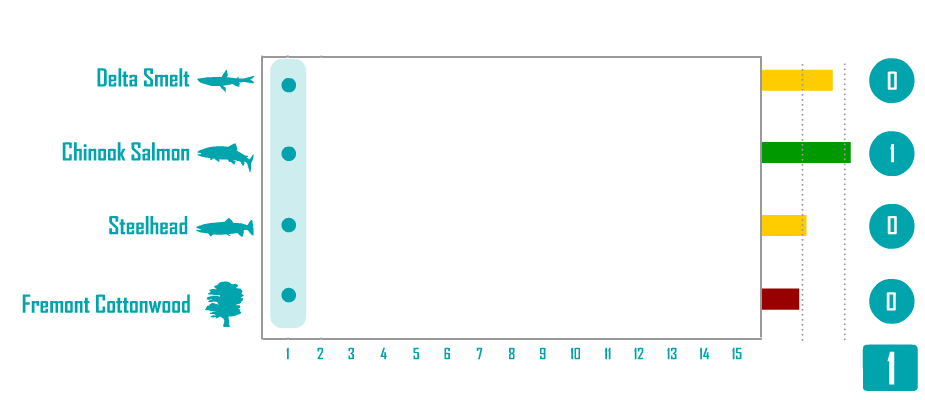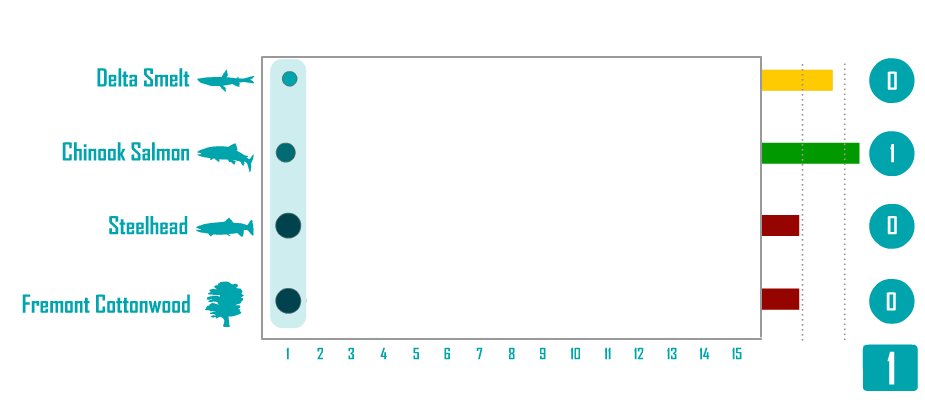Jagger’s Law & Turn Taking Optimization
“You can’t always get what you want”, but Turn Taking Optimization (TTO) creates a flexible way to improve water management and meet the needs of ecosystems, agricultural users and human communities.
 When water is limiting and the world is getting warmer and prone to more extremes, human communities, agricultural users and ecosystems all need to do more with less. Because of competing needs (what’s good for you is sometimes bad for me), there is no single way to satisfy everyone and trade-offs must always be made. Turn Taking Optimization (TTO) creates a smarter way to meet multiple objectives and is based on the idea that species do not need to do well every year, but can “take turns” having their needs met.
When water is limiting and the world is getting warmer and prone to more extremes, human communities, agricultural users and ecosystems all need to do more with less. Because of competing needs (what’s good for you is sometimes bad for me), there is no single way to satisfy everyone and trade-offs must always be made. Turn Taking Optimization (TTO) creates a smarter way to meet multiple objectives and is based on the idea that species do not need to do well every year, but can “take turns” having their needs met.
Using a cloud-based computing framework, TTO has been applied to the Sacramento River and Delta, combining existing simulation and optimization tools for water allocation and management with the Ecological Flows Tool (EFT), creating a flexible multi-objective optimization system that takes turns searching for water allocation solutions that meet the needs of 15 representative species and 31 indicators.
The TTO approach incorporates the existing modelled representation of socio-economic water management criteria, priorities and constraints and optimizes water release patterns each water year using a dynamically shifting set of EFT indicators. Rather than attempting to optimize conditions for all ecological indicators every year, turn-taking creates flexibility and opportunities for different indicators to be successful in different years, informed by the frequency that each species’ ecological needs should be met. As an individual EFT indicator is successful in a particular year, its priority in one or more subsequent years is reduced (and vice versa).
The animations illustrate the difference between current management and management based on TTO, using a hypothetical 15 year period where identical circle sizes represent the identical priority given to meeting the goals of four example indicators. Without TTO the circle sizes remain unchanged over the 15 years and the moving horizontal bars at right show how each indicator receives an annual score which varies from red (Poor) through yellow to green (Good), depending on whether it crosses the dotted vertical lines which define thresholds between the score categories. Those in the Good category are summed up, and an aggregate score of 10 is achieved. In the TTO example the sizes of circles vary, and become smaller once a Good year is achieved, allowing other indicators to receive a higher priority. The end result is an aggregate score of 14; an improvement over the current static priority system.
Comparing TTO to a Reference case scenario based on current management practices, 12 EFT indicators are improved, 14 show no change and 5 show a reduction in suitability. When grouped into 9 species and life-history groups, there was improved performance in 4 (late-fall Chinook, winter Chinook, spring Chinook and Fremont cottonwood), no change in 4 (fall Chinook, Delta smelt, splittail and longfin smelt), and worse performance in 1 group (steelhead).
The animations below illustrate the concept underlying turn-taking optimization. The bars indicate how a species is doing against its indicator benchmarks in a given year, and the numbers at the end of the bars tally each instance of a species achieving a “Good” year. The box at the bottom right tallies the overall number of “Good” years in the entire species assemblage. When using management using a turn-taking approach, more species achieve a greater number of good years than under a conventional management scenario.
Keywords & Themes: Real-time tools / Optimization / Coupled modeling / Water resources / Riparian and geomorphic change / Dam operations / Integrated data / Cloud computing / Integrated modeling / Data visualization / Time-series roll-up
- Improving Multi-Objective Ecological Flow Management with Flexible Priorities and Turn-Taking: A Case Study from the Sacramento River and Sacramento–San Joaquin Delta: https://doi.org/10.15447/sfews.2018v16iss1/art2
- Application of the Ecological Flows Tool to complement water planning efforts in the Delta & Sacramento River: multi-species effects analysis and ecological flow criteria: https://doi.org/10.13140/2.1.3829.1202
- Sacramento River Ecological Flows Tool (SacEFT): Record of Design (v.2.00): https://doi.org/10.13140/RG.2.2.19520.53768
- The Delta Ecological Flows Tool: Record of Design (v1.1): https://doi.org/10.13140/RG.2.2.17842.81609v
Key Contacts
Clint Alexander
President | Practice Area – Environmental Water Mgmt.
Contact us if you have any questions or would like to discuss the current or future Jagger’s Law & Turn Taking Optimization.


